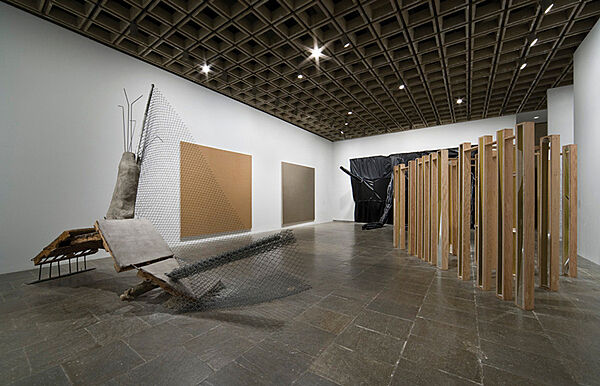Lisa Sigal: 2008 Whitney Biennial
June 17, 2013
Artist Lisa Sigal talks about her 2008 Whitney Biennial work, "The Day before Yesterday and the Day after Tomorrow--a "painting of a painting" that extends throughout the museum.
Lisa Sigal: People are responding to my piece in a very interesting way because I think that they walk in, they don’t quite understand what has happened: "Where is the museum wall?" "Where do you find the museum wall?" And suddenly in my piece, the wall itself kicks out, so then you realize, "Oh. This is very sculptural, this isn’t the museum wall." Every part of this piece is painted. My friends who have seen me go through the entire process still keep saying, "So where did you find this old wallpaper?" And I’m like, "This is not old wallpaper! Do you understand? It’s a painting! It’s a painting."
I was constructing my studio space and in taking down the old walls, I found a wall. So I framed the wall in my studio and for me that act of framing was the first step in making a painting or making a piece. So the piece that I have here in the museum is confusing because it’s actually a painting of a painting. Everything has been created, so my interest in the hole itself leading to the museum wall, and then to the illusion of the hole, all of these are painted holes.
It’s very interesting that a painting can be almost a shelter, or a fort of some sort. This red and white stripe pattern and the piece of bent sheet rock is such a bare suggestion of shelter and yet, that’s the first thing that we think of. In the way that the stripes run through my piece and look for the seams as an exit, I find that the idea of exit and vanishing into the piece, or realizing a kind of presence is really important. And for me, it provides a kind of continuum which actually runs through the entire museum. It creates a kind of pictorial space of the architecture of the stairwell itself; so that you step off the fourth floor I’m hoping that you’ll recall that association of my piece. It’s like depending on where the context is, the meaning of it changes. So for one person, it may be a reference to the artist Daniel Buren; for another it’s the striping that’s in a subway, the danger signal. For another it’s a circus tent, or a flag. And I’m interested in those kinds of associations and the kind of fluctuation of context.

